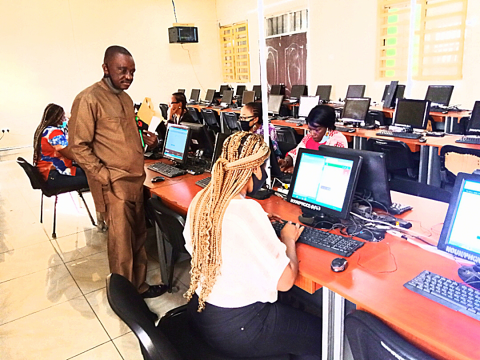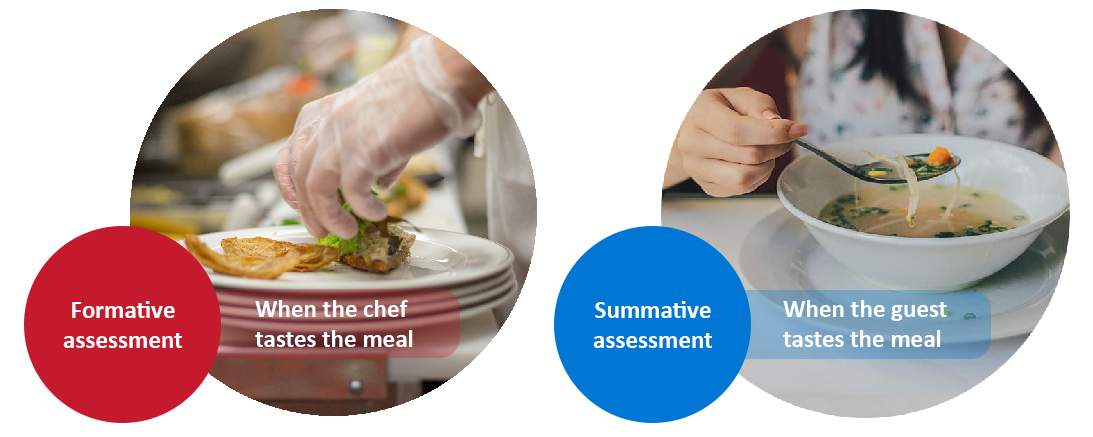What exactly is 'Assessment'
The term assessment refers to the wide variety of methods or tools that educators use to evaluate, measure, and document the academic readiness, learning progress, skill acquisition, or educational needs of learners. Assessments are used by educators to measure, evaluate and document the level of skill and knowledge which a learner has acquired. This unit of study will incorporate the different types of assessment which exist as well as the different assessment tools which are available.
The Stages of Assessment
There are three stages in the assessment process viz.:
- Before learning = diagnostic assessment (aka pre-test): This assessment determines a learner's baseline skill and knowledge prior to the commencement of the learning
- During learning = formative assessment: This assessment takes place during the learning process to modify learning activities and improve the learner's achievement
- After learning = summative assessment: This assessment takes place after the learning process has been completed. It evaluates whether the learner has mastered the learning objective / outcome.

You might have noticed we used an example of diagnostic testing on the previous section when we asked you to rank your assessment proficiencies using a survey. Let's delve into a little more detail for each stage.

Diagnostic Assessment
The diagnostic assessment, also known as a pre-test, provides the teacher with a tool which will determine the learner's individual strengths, weaknesses, knowledge and skills prior to the commencement of learning. Diagnostic assessments can also highlight the areas where difficulties are being experienced and therefore this will assist in determining the most effective lesson plan to ensure that these areas of difficulty are adequately addressed.
Effective diagnostic assessment tools should:
- Allow the teacher to plan meaningful and efficient lessons
- Provide information to assist teachers in individualising their lessons to address learners’ particular needs
- Create a benchmark for assessing future learning.
·Examples of diagnostic assessment tools
Some examples of ICB based diagnostic assessment tools include:
- Reflective journals and / or blogs
- Online questionnaires and surveys (similar to the one which you have just completed)
- Practical assignments.
Examples of online self analysis tools
- YouRock - Diagnostic text aimed at youth that determines 'career choices'. Available online here
- The Ikanos digital skills self assessment test. Available online here.
ICT Tools to develop your own diagnostic tests
Below are just a few examples of various applications which offer the functionality of developing diagnostic tests such as surveys and questionnaires. Can you think of any others?
- Survey Monkey. Available online here
- Moodle's survey and questionnaire tools. You might have noticed we used the questionnaire tool in the introduction to rank your assessment proficiencies.
Formative Assessment
Formative assessments are in-process evaluations of learners’ learning that are typically administered multiple times during a unit, course, or academic program. The general purpose of formative assessment is to give educators in-process feedback about what students are learning or not learning so that instructional approaches, teaching materials, and academic support can be modified accordingly. Formative assessments are usually not scored or graded, and they may take a variety of forms, from more formal quizzes and assignments to informal questioning techniques and in-class discussions with student
· Watch the video below to get a clear understanding on what a formative assessment actually is.
·
![]() WCPS Training. (2017). What is formative assessment? (CC Attribution
license - reuse allowed)Page
WCPS Training. (2017). What is formative assessment? (CC Attribution
license - reuse allowed)Page
·
A practical analogy of formative vs summative assessments is illustrated below.

Self-Assessment Exercise
Examples of formative assessment activities include:
- Mind mapping
- Teacher observation
- Quizzes (with immediate feedback)
- Learner self assessment.
Examples of digital tools to support formative assessments:
- Coggle for mind mapping. Available online here
- Moodle Cloud assessment tools for quizzes. Available online here
- Google classroom. Available here. (Requires a free Gmail account)
- Wordpress blog for self assessment and reflection. Available online here
Evaluate various software packages to select the tool/s which you are most comfortable with in creating formative assessments.
Continuous formative assessments
Watch the short video below which discussing the advantages of implementing continuous formative assessments.
e-Literate TV. (2018). Continuous formative assessments (CC Attribution licence - reuse allowed)Page
Summative Assessment
Review the video below which elaborates on what a summative assessment is.
![]() CSER. (2018). Summative assessment (CC Attribution licence
- reuse allowed)
CSER. (2018). Summative assessment (CC Attribution licence
- reuse allowed)
So to summarise:
- The aim of a summative assessment is to evaluate the level of learning at the end of the learning process
- This evaluation should be compared against a learning outcome or objective
- Generally, summative assessments are high stakes, meaning that they have a high mark value whereas formative assessments have relatively low stakes.
Examples of summative assessments include:
- Tests / examinations
- Literature reviews
- Projects
- Portfolios
Formative vs summative assessments
Watch the video below which provides an overview on the differences between formative and summative assessments.
Hexis Plus Training. (2016). Formative and summative assessmentPage